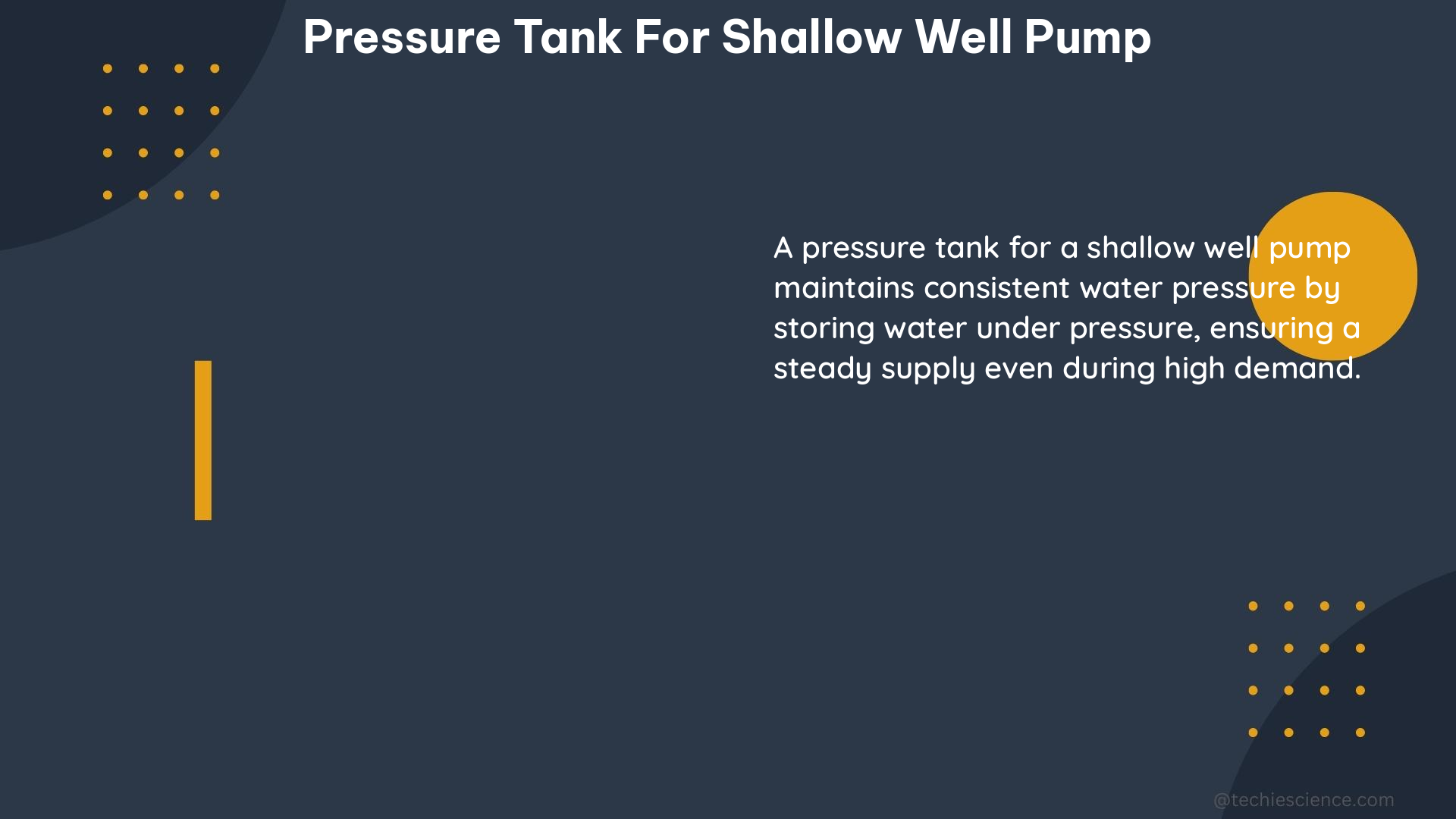Selecting the right pressure tank for your shallow well pump is crucial to ensure efficient and reliable water supply. The optimal pressure tank size depends on various factors, including the flow rate, the system’s cut-in and cut-out pressure, and the desired runtime or time between cycles. A larger pressure tank generally translates to longer motor life and reduced risk of premature pump failure by extending the time between cycles.
Understanding Pressure Tank Drawdown Capacity
The drawdown capacity of a pressure tank, which is the available volume of water in the tank, may not necessarily match the tank’s volume. For instance, a 20-gallon pressure tank might only have a drawdown capacity of about 4.5 to 6.5 gallons, depending on the operating pressure of the system. This is because the bladder’s expansion limit within the tank determines the actual drawdown capacity, not the tank’s total volume.
Factors to Consider When Sizing a Pressure Tank

To size a pressure tank properly, you need to consider the following factors:
-
Flow Rate: Determine the flow rate of your shallow well pump, which is the volume of water it can deliver per unit of time, typically measured in gallons per minute (GPM).
-
Cut-in and Cut-out Pressure: Identify the cut-in and cut-out pressure of your system, which are the pressure levels at which the pump turns on and off, respectively. This information is crucial for selecting the appropriate pressure tank.
-
Target Runtime or Time Between Cycles: Ensure that the minimum run time for motors smaller than 1 horsepower is at least 1 minute, and for larger motors, aim for a runtime of at least two minutes. This helps extend the motor’s lifespan and reduces the risk of premature pump failure.
Calculating the Proper Pressure Tank Size
To determine the proper size of the pressure tank, you’ll need to know the flow rate, the system’s cut-in and cut-out pressure, and the target runtime or time between cycles. Here’s a step-by-step guide:
-
Determine the Drawdown Volume: Calculate the drawdown volume, which is the amount of water the pump can deliver before the pressure drops to the cut-in level. This is typically between 4.5 to 6.5 gallons for a 20-gallon tank, depending on the operating pressure.
-
Calculate the Cycle Time: Divide the drawdown volume by the flow rate to determine the cycle time, which is the time it takes for the pump to refill the tank from the cut-in to the cut-out pressure.
-
Select the Appropriate Tank Size: Choose a pressure tank size that provides the desired runtime or time between cycles. As a general rule, the tank size should be at least 2 to 3 times the drawdown volume to ensure the pump runs for at least 1-2 minutes.
For example, if your shallow well pump has a flow rate of 5 GPM, a cut-in pressure of 30 psi, and a cut-out pressure of 50 psi, and you want a minimum runtime of 2 minutes, you would need a pressure tank with a drawdown capacity of at least 10 gallons (2 minutes x 5 GPM). Considering the typical drawdown capacity of a 20-gallon tank, this would suggest using a 20-gallon or larger pressure tank for your system.
Technical Specifications of Pressure Tanks for Shallow Well Pumps
Here are the key technical specifications to consider when selecting a pressure tank for your shallow well pump:
| Specification | Details |
|---|---|
| Tank Material | Typically made of steel, stainless steel, or fiberglass |
| Tank Capacity | Ranges from 2 to 100 gallons or more |
| Drawdown Capacity | Depends on the operating pressure and bladder size, typically between 4.5 to 6.5 gallons for a 20-gallon tank |
| Pressure Range | Typically between 20-60 psi, but can vary based on the specific application |
| Mounting Options | Available in vertical or horizontal configurations, with various mounting brackets and kits |
| Connections | Available with male or female NPT (National Pipe Thread) connections for easy installation |
DIY Pressure Tank Installation for Shallow Well Pump
Follow these steps to install a pressure tank for your shallow well pump:
-
Determine the Appropriate Tank Size: Based on the flow rate, cut-in and cut-out pressure, and target runtime, select the appropriate pressure tank size for your system.
-
Choose the Tank Material: Select a tank made of suitable material for your application, such as steel, stainless steel, or fiberglass.
-
Verify the Pressure Range: Ensure the tank has the correct pressure range for your system, typically between 20-60 psi.
-
Confirm the Capacity and Drawdown Capacity: Choose a tank with the appropriate capacity and drawdown capacity for your needs.
-
Select the Mounting Option: Choose a tank with the correct mounting options, such as vertical or horizontal configurations, and the necessary brackets and kits for installation.
-
Install the Tank: Follow the manufacturer’s instructions to install the tank, ensuring proper connections and seals.
-
Test the System: After installation, test the system to ensure proper operation and adjust the pressure switch if necessary.
By following these steps, you can ensure that your shallow well pump system is equipped with the right pressure tank for optimal performance and longevity.
References
- How to Size a Pressure Tank – YouTube
- Why is the recommended pressure for a bladder tank 2 psi less that well pump activation pressure
- Well Pump Pressure Tank Size? – Love Plumbing & Remodel

The lambdageeks.com Core SME Team is a group of experienced subject matter experts from diverse scientific and technical fields including Physics, Chemistry, Technology,Electronics & Electrical Engineering, Automotive, Mechanical Engineering. Our team collaborates to create high-quality, well-researched articles on a wide range of science and technology topics for the lambdageeks.com website.
All Our Senior SME are having more than 7 Years of experience in the respective fields . They are either Working Industry Professionals or assocaited With different Universities. Refer Our Authors Page to get to know About our Core SMEs.